EGYPTOLOGY: Apotropaica in Ancient Egypt
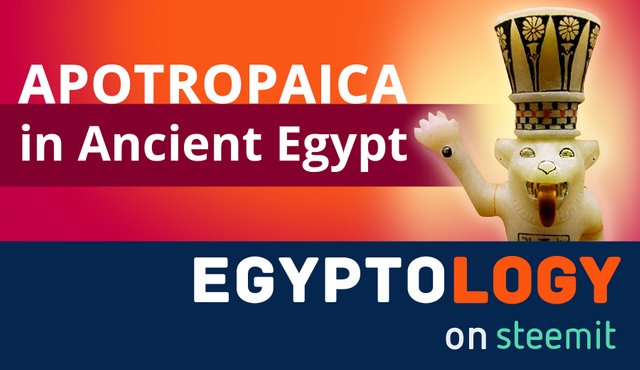
Today we go a bit deeper down the rabbit hole. As a reader of my blog you probably know that I sometimes write about some stuff that is "not from this world". ;) And indeed, the Ancient Egyptian culture bears a very complex system of magical actions that need to be understood before we can draw conclusions about their way of thinking. The following article is something for everybody who wants to learn more details about magic in Ancient Egypt. I also encourage you to read my other article on magic in general. You are welcome to ask any question at any time. Let's explore the consciousness of our ancestors together.
What is an "Apotropaicon"?
At first, we should have to look at the term. It derives from the Greek word αποτρπαιος, which means "to defend" or "to fight".
Apotropaica are things that act for defending dangers. The way, the intensity and the duration of how they work are determined by their material, colour, shape and other attributes that can be visible or not. A certain information about a thing, for example, the colour, can
(1) have a direct effect on the outcome, or
(2) the preferred outcome can be attached to that attribute through a magical act (a ritual).
The colour yellow was connected with the sun. So yellow objects could be used in magical acts where the sun played a role. This would be something that pointed out on number 1 above. But also a completely different object with no special attributes could have the same effect, when the person who executed a ritual firmly dedicated an effect to an object by a magical speech, certain words, a hymn or by an action, for instance by burning incense or similar. They "glued" an object together with a magical effect.
How Does it Work?
Even if I repeat myself, but this is important to keep in mind: for the Ancient Egyptians, all that existed had a counterpart! It can be compared with the hermetic axiom "as above so below". The river Nile separated the eastern and the western desert. They crossed the Nile sometimes in a ritual manner: they celebrated the transition from one point to its exact opposite. But this was not just done for itself. Considering always both points – the east and the west, the north and the south, the yesterday and the tomorrow, the day and the night – guaranteed to them the existence in eternity!
This is a bit complicated to understand from our modern perspective. But let me give you an example, that is – of course – not an original Ancient Egyptian one, but I want to use it to simplify the steps of a magical act.
Let's say you have an exam next week and you studied hard, but you still feel afraid of failing. You can now take the good result from a previous exam, print it out and stick it to your desk. It keeps always visible and in this way you "feed" your mind with the information of a "passed exam with a good result". But additionally, you have to remove the information of "failing". Now the Ancient Egyptians would do the following: they write "fail" on a piece of paper and throw this in the garbage with the words "fail - go away!".
So, you see here the big difference of modern esoteric "wishful thinking" in terms of "just believe in your success and everything is fine." This is a trap – at least for the Ancient Egyptian mind. They were always aware of the "other half" of an event.
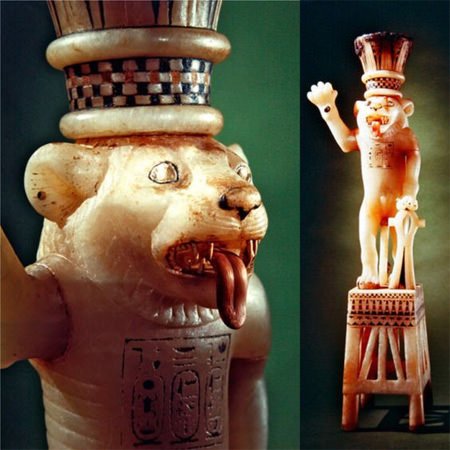
Img 1: Apotropaic Alabaster Vessel of Tutanchamun Source
And also Apotropaica were believed to work that way. Their function was to prevent a (harmful) event to happen. Objects could be shaped to have a scary appearance, for example, a figure with a demon-like head, with a widely opened mouth and a threatening gesture. In a ritual, when texts were recited, the intensity of the effect could be increased. Additionally, the "other half" of the effect had to be considered. In the words, they spoke they had not only to mention what they did not want but always what they wanted to come out instead!
In the following paragraph, I will show you an example of an apotropaic action, that was very common in the Ancient Egyptian society.
Breaking of the Red Pots
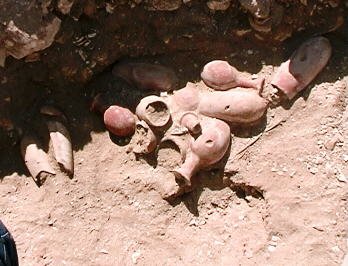
Intentional broken pottery Source
This is a special ritual that was called sḏ dšrw.t (spoken: sedj desheret) in the Egyptian language. There was pottery found in tombs that were at first thought to be damaged through time by geological movements within the tomb. But later Egyptologists discovered a special decoration on it that lead to the conclusion that these pots must have had been broken intentionally during the funeral. The pieces of the pottery contained the names or images of enemies and now we know: by breaking the names of those enemies they never had a chance to harm the deceased one. The Ancient Egyptian people believed that and so many of such red destroyed pots were found in tombs during almost all periods, beginning from the 6th dynasty and ending in the 18th dynasty.
More Examples
Other apotropaic actions were, for example, the "burning of the fans", where fans were painted with the faces of the enemies and burned with the intention to destroy their influence.
Magical knifes were used to keep danger away from a person. They are also called "birth knifes" because of their function to protect mother and child. Such objects were made of hippo ivory and could bear several inscriptions and depictions of Gods and Goddesses.
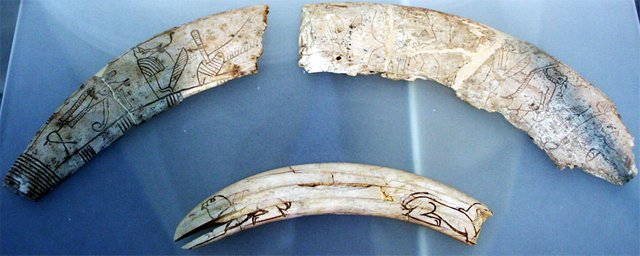
So-called "Hypocephaloi" (Greek origin: ὑπό = below, and κεφαλή = head → below the head) were amulets of the Late Period (Greco-Roman times) that had the shape of a disk with magical texts written on it. They were put below a mummy's head to keep the deceased warm and to prevent tomb raiders from stealing the grave goods.
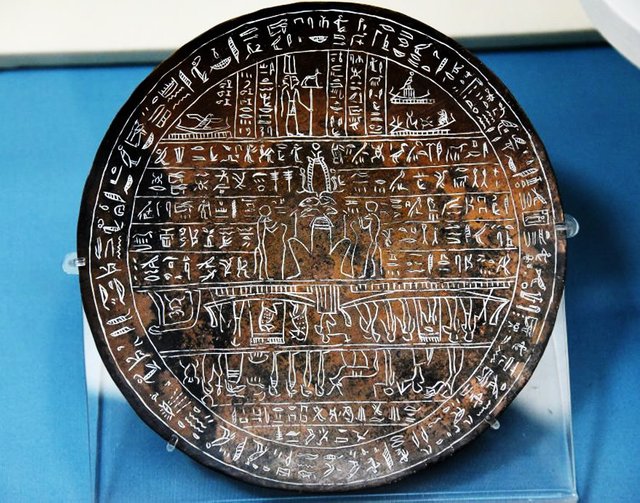
Magical bricks or also called "birth bricks" were very important in the foundation ceremony when a new building was created. This was probably the first brick of a house and it was inscribed with magical texts to prevent danger from the house and to attract good forces to protect the building. It was masoned hidden into the wall of the house.
And last but not least, this is also very special: the flip-flops of Pharao Tutanchamun, that had the pictures of the enemies on their soles. With every step the King took, he stepped on his enemies, to keep them down on the ground!
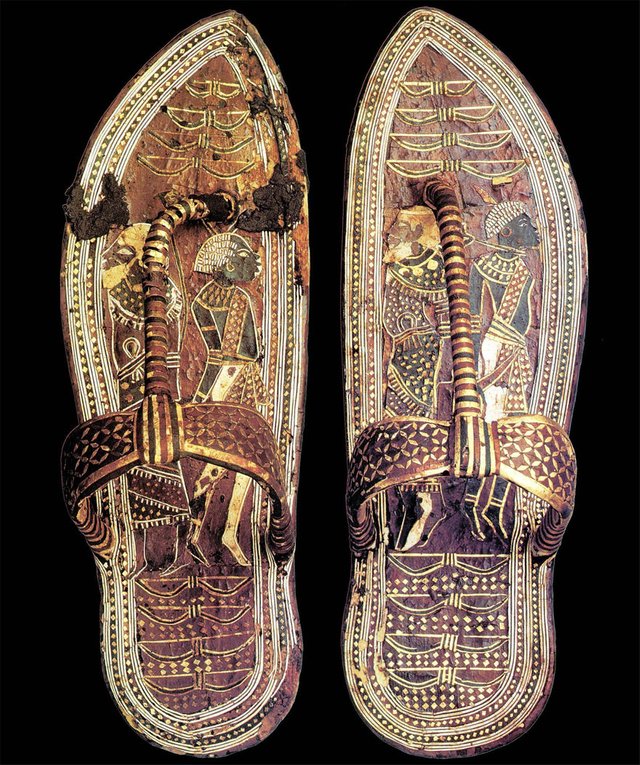
Sources:
• Altenmüller, Hedwig, in: Lexikon der Ägyptologie I, 1975, cols. 355–357, s.v. Apotropaikon.
• Bonnet, Hans, Lexikon der ägyptischen Religionsgeschichte, 2000, p. 320, s.v. Hypokephalos.
Darvill, T.(2008). apotropaic. In The Concise Oxford Dictionary of Archaeology. : Oxford University Press. Retrieved 10 Dec. 2017, from http://www.oxfordreference.com/view/10.1093/acref/9780199534043.001.0001/acref-9780199534043-e-208.
• Bowker, J.(2000). Hermeticism. In The Concise Oxford Dictionary of World Religions. : Oxford University Press. Retrieved 10 Dec. 2017, from http://www.oxfordreference.com/view/10.1093/acref/9780192800947.001.0001/acref-9780192800947-e-3081.
• van Dijk, Jan, in: Lexikon der Ägyptologie VI, 1986, cols. 1389–96, s.v. Zerbrechen der roten Töpfe.
• Roth, Ann Macy / Roehrig, Catharine H., Magical bricks and the bricks of birth, in: The journal of Egyptian archaeology, 88, Egypt Exploration Society, 2002, pp. 121–139. http://www.jstor.org/stable/3822340
• http://www.aegyptologie.com/forum/cgi-bin/YaBB/YaBB.pl?action=lexikond&id=050416162459
Feel free to ask all the question of what you always wanted to know about Ancient Egypt. That’s my job and my passion. Let’s discuss your thoughts and ideas.

If you liked this article, please follow me on my blog @laylahsophia. I am a german Egyptologist writing about ancient and contemporary Egypt, history of science, philosophy and life.
I definitely can't speak Egyptian :)
This was a cool post. I am always amazed to read about the beliefs of the more ancient people. Of course, this is something laughable today, with the knowledge of today. But thousands of years ago.... well...
Truly fascinating. I see a connection with Wicca magic. I have not read your information on magic in general.
@laylahsophia this is a great practice, i will like to practice the last one myself, but what if all politcian happen to be my enemy. Is that not trouble on it own ?
Well, I think you first have to define "enemy". Why are all politicians your enemy? Are they really able to harm you or do you just disagree with them? ;)
Tutanchamun put a special kind of enemies on his shoes, who –from his perspective – threatened Egypt and intended to destroy the peace.
Hmmm....i think you make a good point.
But to be honest going to the extent of getting your enemy picture on your sandals means a lot of hatred.
I would not call it "hatred". It is loyalty to his own country. As the king he was responsible for the well being of his nation. And beside this he was very young when I ascended the throne. He was not a famous warlord. So this kind of magic was one of his "strategy" to keep his country in peace.